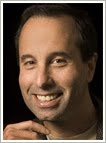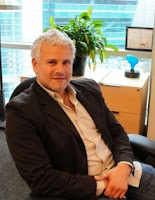Our guest this month is Andrew Huberman, an assistant professor in the department of neurobiology at UCSD. Dr Huberman is interested in a classic question in development—how do the eyes connect to the brain? Cells known as retinal ganglia cells (RGCs) receive information from photoreceptors in the retina and carry this information to the brain. Connections from the left eye and right eye connect to the same part of the brain early on, but sort into two groups during maturation. Furthermore, different subtypes of RGCs respond to color, motion, and brightness and these subtypes target separate, designated regions of the brain. Andrew and his lab are exploring the mechanisms that guide the separation of different subtypes of RGCs during development. At the end of our interview, he explains the role of electrical activity and different genes in guiding the migration of these cells during development as well as how a course on the biology of behavior inspired him to pursue a career in neuroscience.
More on the Huberman Lab's research
December 22, 2010
December 08, 2010
How neurons navigate their way around in the developing brain: David Van Vactor
Harvard University
Dec. 8, 2010 (Hosted by Osama Ahmed)
Your brain is composed of a tremendous number of neurons that make very specific connections with each other. The formation of this extremely complex circuit requires that each neuron find its appropriate target. Dr. David Van Vactor and his lab at Harvard University study the cellular machinery that help motor neurons navigate and find their correct partners, muscles, during development. They are also investigating how the neuromuscular junction is formed and maintained once the neuron reaches its destined target. At the end of our talk with David, he discusses the experiences in elementary school and college that led him to a career in science.
More on the Van Vactor Lab's research
May 15, 2010
What fruit flies can tell us about alcohol addiction: Ulrike Heberlein
In this week’s episode we talk to Dr. Ulrike Heberlein, a professor in the department of anatomy at UCSF and baseball aficionado. This year, she was elected to the National Academy of Sciences, one of the highest honors that can be awarded to an American scientist.
Dr. Heberlein is interested in the genes that underlie alcoholism and drug addiction and uses a seemingly unusual animal model to study it—the fruit fly. Using this model, her lab has identified a gene dubbed happyhour that, when mutated, can reduce an organism’s response to alcohol. She discusses how her lab uses the findings in the fly to guide further experiments in rodents and how these discoveries may soon lead to developing treatments for alcohol addicts.
More on the Heberlein Lab's research
Hosted by Sama Ahmed
Dr. Heberlein is interested in the genes that underlie alcoholism and drug addiction and uses a seemingly unusual animal model to study it—the fruit fly. Using this model, her lab has identified a gene dubbed happyhour that, when mutated, can reduce an organism’s response to alcohol. She discusses how her lab uses the findings in the fly to guide further experiments in rodents and how these discoveries may soon lead to developing treatments for alcohol addicts.
More on the Heberlein Lab's research
Hosted by Sama Ahmed
May 05, 2010
How your brain tells time: Michael Shadlen
Our guest this week is Michael Shadlen, a professor at Washington University, HHMI investigator, and avid jazz guitarist.
Some neurons in our brain help us sense our environment while others help us move our body parts. Dr. Shadlen is interested in the neurons that link sensory information with behavior—the neurons that help us think and decide. He is also interested in how our brain can keep track of time. Learn how Michael and his lab record from the brains of monkeys to study these processes.
More on the Shadlen Lab's research
Producer: Sama Ahmed
April 16, 2010
Dapper in the brain: Benjamin Cheyette
Dr. Ben Cheyette is an assistant professor in the department of psychiatry at UCSF. Ben and his lab focuses on signaling proteins that help neurons develop and communicate with each other.
In this week’s episode Dr. Cheyette explains how these signaling pathways originally discovered in the fruit fly relate to psychiatric disorders in humans. He discusses how he became interested in this family of proteins and the research his lab is currently conducting. Using the power of mouse genetics, his lab studies how a protein called Dapper can shape the way neurons form and function in the brain. He is also interested in how mutations in the Dapper gene relate to autism. Finally, at the end of our talk Ben provides some helpful advice to young listeners interested in pursuing a career in science.
More on the Cheyette Lab's research
Hosted by Osama Ahmed
In this week’s episode Dr. Cheyette explains how these signaling pathways originally discovered in the fruit fly relate to psychiatric disorders in humans. He discusses how he became interested in this family of proteins and the research his lab is currently conducting. Using the power of mouse genetics, his lab studies how a protein called Dapper can shape the way neurons form and function in the brain. He is also interested in how mutations in the Dapper gene relate to autism. Finally, at the end of our talk Ben provides some helpful advice to young listeners interested in pursuing a career in science.
More on the Cheyette Lab's research
Hosted by Osama Ahmed
April 07, 2010
Repression of olfactory receptor genes: Stavros Lomvardas
Dr. Stavros Lomvardas, assistant professor in the department of anatomy at UCSF, is interested in olfactory receptor choice.
About 900 genes encode the receptor proteins in your nose that help you smell. However, each neuron in the olfactory epithelium expresses only one of those genes. Dr. Lomvardas is interested in how the nervous system “chooses” which receptor protein is expressed. In this episode, Stavros explores the cellular machinery that selectively enhances or silences the expression of genes and how these discoveries were made.
More on the Lomvardas Lab's research
Hosted and produced by Sama Ahmed
March 17, 2010
Memory of a relapse: Patricia Janak
In conjunction with being a professor at UCSF, Dr. Patricia Janak heads a lab at the Ernest Gallo Clinic and Research Center. There, Patricia and her fellow scientists tackle questions related to drug and alcohol abuse.
In this week’s episode, she shares with us some of her work on alcohol and drug addiction. Learn why some addicts have sudden cravings for drugs or alcohol and about the brain regions that are necessary for a relapse to happen.
More on the Janak Lab's research
Hosted by Sama Ahmed
In this week’s episode, she shares with us some of her work on alcohol and drug addiction. Learn why some addicts have sudden cravings for drugs or alcohol and about the brain regions that are necessary for a relapse to happen.
More on the Janak Lab's research
Hosted by Sama Ahmed
March 02, 2010
Local neural networks associated with flexible behaviors: Takaki Komiyama
Our guest this weeks has been wondering the same thing. Dr. Takaki Komiyama is a postdoctoral fellow at Janelia Farms, currently working in the Svoboda Lab. He is interested in how the brain codes for flexible behaviors, such as learning to play tennis. With practice, you generally see an improvement in your game. Sooner or later, your swings become smoother and you become better at predicting where the ball will land. But how does your brain code for it all? Listen in to this week’s episode and find out.
More on the Komiyama Lab's research
Producer: Osama Ahmed
More on the Komiyama Lab's research
Producer: Osama Ahmed
February 16, 2010
The genetics of morning larks: Louis Ptacek
In this week’s episode, Dr. Louis Ptacek, an investigator for the Howard Hughes Medical Institute and a professor at the University of California - San Francisco, discusses how alterations in our genes (called “mutations”) are responsible for why "morning larks" have to wake up in the middle of the night.
Louis is interested in understanding certain aspects of normal brain function, such as sleep. In my chat with him, he talks about our body’s natural circadian rhythm and how it is controlled by a “feedback loop” that controls gene expression and protein construction.
More on the Ptacek Lab's research
Hosted by Osama Ahmed
Louis is interested in understanding certain aspects of normal brain function, such as sleep. In my chat with him, he talks about our body’s natural circadian rhythm and how it is controlled by a “feedback loop” that controls gene expression and protein construction.
More on the Ptacek Lab's research
Hosted by Osama Ahmed
February 03, 2010
The meninges help the brain develop: Sam Pleasure
In this week’s session, we learn about the meninges. These are the membranes that cover and protect our central nervous system (our brains and spinal cords). More specifically, we learn from Dr. Sam Pleasure that the meninges may also help our brains develop. He also describes the role of two brain regions that his work focuses on: the hippocampus and the neocortex.
More on the Pleasure Lab's research
January 20, 2010
Ignoring distractions helps you remember better: Adam Gazzaley
Dr. Adam Gazzaley is interested in the interface between attention and memory. In this installment, he tells us about the tools he’s using to study how distractions affect our ability to remember. He’s recently discovered that older adults have a hard time ignoring irrelevant information, and that this may have a huge negative effect on their memory. Find out how he’s building a video game to help people ignore distractions, and hopefully remember better.
More on the Gazzaley Lab's research
Hosted by Osama Ahmed
More on the Gazzaley Lab's research
Hosted by Osama Ahmed
January 06, 2010
The Link Between Muscle Degeneration and Mechanosensitive Ion Channels: Jeff Lansman
Dr. Jeff Lansman explains what mechanosensitive
ion channels are and their role in helping a cell sense forces such as touch.
He’s using a genetic approach to understand how a mutation that causes
cytoskeletal protein loss can lead to muscle death. Near the end, he shares
with us how his interest in marine biology inspired him to study ion channels.
Subscribe to:
Comments (Atom)











